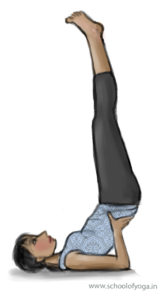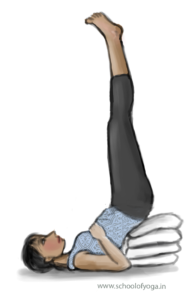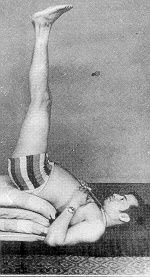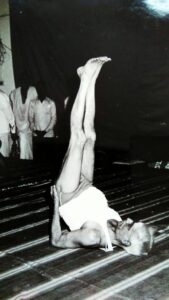What is viparīta-karaṇī (inverted action pose)?

Viparīta-karaṇī is an āsana where the practitioner holds the legs and hips perpendicular to the torse and the torse between 45 and 60 degrees off the ground. Since it is difficult to hold the hips in this position for extended periods of time, Yogacharya Sundaram devised a method of enabling the practitioner to hold the pose for longer durations with less stress. This is called sundara-viparīta-karaṇī.
How should one practice sundara-viparīta-karaṇī? (Should be learned under supervision)
- First, place 3-5 hard pillows on the mat in such a way that the pillows are at an incline of 60 degrees with respect to the floor.
- Then, sit at the opposite end of the pillows and slowly lower the torso over the incline on the opposite side so that the shoulders rest on the floor.
 Importantly, ensure that torso is at 45 degrees to the floor.
Importantly, ensure that torso is at 45 degrees to the floor.- Now, folding the legs over the pillows towards the body and raise them straight into the air.
- Next, bring the legs towards the face, so that the legs and torso are about 90 degrees with each other.
- After this, place your hands at the sides of the pillows or across the chest.
- Finally, hold this position for 5 minutes, increasing up to 20 minutes. One can also split the practice into 2 periods between 3-10 minutes in duration.
- Lastly, come back to sthithi position in reverse order.
- The dṛṣṭi (gaze) recommended is pādayorāgre (toe of the foot gaze).
What are the sundara-viparīta-karaṇī variations?
Should hard pillows not be available, it is possible to perform sundara-viparīta-karaṇī by supporting the hip with the hands.
- Sthithi (starting) position: First, lie down on a blanket and keep your hands at the sides,
- Next, bend the knees over the torso to touch the forehead with the knees.
- Further, supporting the hips with the hands just above the hip bone, lift the hips off the floor, such that the torso is at 45 degrees to the floor.
- Lastly, lift the legs strainght up and align it such that it is at 90 degrees to the torso.
What are the benefits of practicing sundara-viparīta-karaṇī?

- Firstly, this mudra ensures concentration of blood supply to the heart, lungs, liver, pancreas, kidneys, stomach and respiratory tract.
- Also, sundara-viparīta-karaṇī is good for all illnesses related to the torso and neck, including respiratory disorders, heart and digestion disorders.
- Additionally, this mudra builds resistance to all forms of allergies, colds and flu.
- Sundara-viparīta-karaṇī is excellent for treating digestive ailments, especially those related to the stomach, liver and bowels.
- Lastly, sundara-viparīta-karaṇī helps in stabilising the female reproductive organs and alleviates menstrual discomfort and cramps.
What are the possible sundara-viparīta-karaṇī contraindications?
- First, if you have any form of back ache, do not attempt this mudra without adequate supervision and support.

- Importantly, people with cardiac problems, lower back problems and circulatory disorders should not attempt this mudra without first consulting a physician.
- Also, viparīta-karaṇī hould not to be done by people having neck ailments like cervical or lumbar spondylosis or arthritis.
- Finally, people with hernia etc should avoid this mudra.
- Lastly, his mudra should not be practiced during menstruation or pregnancy.
Hatha Yoga Pradeepika on viparīta-karaṇī.
Ch 3- v7 viparitakarani, vajroli and sakticalana; these are the 10 mudras which destroy old age and death.
Ch 3 – v77 vipareetakarani: That nectar of the moon which has divine qualities gets digested by the Sun and induces ageing.
v 78 There is a divine technique by which the Sun’s face can be cheated. This should be learned under a Guru and not through theoretical study or discussions.
v 79 When the navel is above and palate below, the Sun above and moon below, then this is vipareetakarani. This should be leaned through instructions of a Guru.
v 80 In the case of one who practices this daily, the gastric fires (jataragni) are increased, so one should eat sufficient food.
v 81 If one eats non-nutritious food, then the heat will quickly consume the practitioner. On the first day, stand on the head with feet up, for only a brief moment.
v 82 Increase the duration gradually every day. After 6 months, the wrinkles and grey hair disappear. He, who practices it daily for a yama (3 hours) daily, conquers death.
Some noteworthy points on sundara-viparīta-karaṇī
Internal Links: Dharma (conditioning), Stress and Situational Awareness, Prana, Asana sequence, Asana schedule, Asana Focus or gazing, Pranayama, Hatha Yoga Pradeepika
External Links: Prana, Chakra, Pancha Tattva, Pancha Prana, Pancha Kosha, Nadi,
Yogacharya Sundaram demonstrates Vipareeta Karani @ age 80+
- Viparīta-karaṇī = viparīta = inverted + karaṇīa = action in Sanskrit. The torso should be at right angle to the legs and toes should form a hypotenuse with the head.
- This is one of the easiest and most effective asanas for overall maintenance of health.
- Initially, practitioners will find difficulty in maintaining position, but over time, this will stabilise.
- Also, it may be difficult to maintain position for extended period of time. So, one should initially split this effort into 3-5 minutes twice with a rest interval of 2 minutes. Over time, this can be made into a single effort with time taken up to 15 minutes
Clearly & in detail very well explained.
Dhanyavād.
Thank you for your support